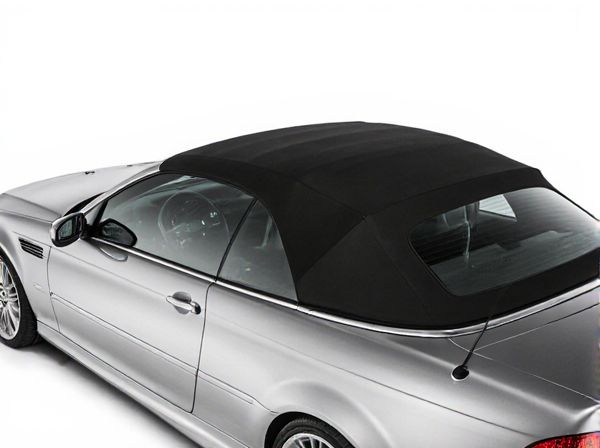
Photo illustration: Convertible Roof vs Retractable Hardtop
Convertible roofs offer a classic, lightweight design that folds down for an open-air experience, providing a traditional aesthetic and often better ventilation. Retractable hardtops combine the benefits of a coupe and convertible by using a solid roof that folds into the trunk, enhancing security and insulation while maintaining sleek styling. Your choice depends on whether you prioritize the tactile feel of fabric or the durability and noise reduction of a hardtop.
Table of Comparison
| Feature | Convertible Roof | Retractable Hardtop |
|---|---|---|
| Material | Soft fabric or vinyl | Rigid metal or composite panels |
| Weight | Lighter | Heavier |
| Durability | Less durable, prone to wear and tear | Highly durable and weather resistant |
| Insulation | Poor sound and thermal insulation | Superior soundproofing and temperature control |
| Operation Mechanism | Manual or electric folding soft top | Fully automatic folding hard panels |
| Opening Time | Quick (seconds to a minute) | Slower (30 seconds to over a minute) |
| Storage Space | Less trunk intrusion | Significant trunk space reduction when retracted |
| Maintenance | Requires regular cleaning and weatherproofing | Lower maintenance demands but complex mechanics |
| Cost | Generally more affordable | Higher manufacturing and repair costs |
Introduction: Convertible Roofs vs Retractable Hardtops
Convertible roofs feature a flexible fabric top that folds down, offering a classic open-air driving experience while often being lighter and more affordable. Retractable hardtops utilize a rigid roof panel that folds into the trunk, providing enhanced security, insulation, and a quieter cabin environment. Both options balance style and functionality, but the choice depends on priorities like weather protection, noise reduction, and vehicle aesthetics.
Key Definitions: What Are They?
A convertible roof is a flexible, fabric or vinyl top that can be manually or automatically folded back to provide an open-air driving experience, typically found in classic roadsters and sports cars. A retractable hardtop is a solid, rigid roof made of metal or composite panels that folds and stows automatically into the trunk, offering enhanced security, insulation, and weather protection compared to a traditional convertible roof. Both systems transform a coupe into a convertible but differ significantly in materials, mechanisms, and functionality.
Design Differences Explained
Convertible roofs feature a flexible fabric material that folds back, offering a lightweight and classic soft-top design with simpler mechanisms. Retractable hardtops use rigid panels made of metal or composite materials that fold and stack within the trunk space, providing superior insulation, security, and a sleek, modern aesthetic. The primary design difference lies in the structural complexity and material choice, impacting durability, noise reduction, and vehicle weight.
Aesthetic Appeal and Style Options
Convertible roofs offer a classic, elegant aesthetic with fabric materials that come in various colors and textures, providing a traditional open-air experience beloved by enthusiasts. Retractable hardtops boast a sleek, modern design with a sturdy metal or composite structure, often featuring seamlessly integrated panels that maintain the vehicle's coupe-like appearance when closed. Style options for convertibles emphasize timeless charm and customization, while retractable hardtops prioritize contemporary sophistication and aerodynamic profiles.
Weather Protection and Durability
Convertible roofs made of fabric offer moderate weather protection but are more susceptible to wear from rain, UV rays, and temperature changes, leading to potential leaks and material degradation over time. Retractable hardtops provide superior weather resistance with robust seals and materials that better withstand harsh conditions, minimizing water intrusion and extending durability. The hardtop's solid construction also offers enhanced insulation, reducing noise and improving temperature control inside the vehicle compared to fabric roofs.
Maintenance and Longevity
Convertible roofs, typically made of fabric or vinyl, require regular cleaning, waterproofing, and inspections to prevent wear and mold, with potential issues like fabric tears and fading shortening their lifespan if neglected. Retractable hardtops, constructed from metal or composite panels, demand maintenance of mechanical components such as motors, hinges, and seals but generally offer superior durability and weather resistance, extending the vehicle's longevity. Choosing between the two depends on maintenance commitment; retractable hardtops often incur higher repair costs but provide enhanced protection and durability compared to fabric convertible roofs.
Noise Levels and Cabin Comfort
Convertible roofs often produce higher noise levels due to their fabric materials, which provide less insulation against wind and road noise compared to retractable hardtops. Retractable hardtops offer enhanced cabin comfort by using rigid panels that create a more airtight seal, reducing external noise and improving temperature control. Noise reduction performance in retractable hardtops can reach decibel levels 5-10 dB lower than soft-top convertibles, enhancing passenger comfort during long drives.
Security Concerns Compared
Convertible roofs, typically made of fabric, offer less security due to their vulnerability to break-ins and vandalism, as they can be easily cut or torn. Retractable hardtops provide enhanced protection because their solid panels are more resistant to forced entry and environmental damage. Security systems and reinforced locks integrated into retractable hardtops further improve theft deterrence compared to traditional convertible roofs.
Cost Analysis and Value for Money
Convertible roofs typically cost less upfront compared to retractable hardtops, making them a budget-friendly option for drivers seeking open-air experience. Retractable hardtops offer greater durability and improved insulation, which can justify their higher price through enhanced comfort and potential long-term savings on maintenance and repair. Evaluating total ownership costs, including installation, upkeep, and resale value, retractable hardtops often deliver superior value for money despite the initial investment.
Choosing the Right Option for You
Convertible roofs offer a classic open-air experience with fabric materials that are lightweight and often more affordable, ideal for drivers valuing style and breathability. Retractable hardtops provide enhanced security, insulation, and noise reduction due to their solid panels, making them suitable for those prioritizing comfort and year-round usability. Consider climate, budget, and desired driving experience to determine whether the traditional charm of a convertible roof or the practicality of a retractable hardtop aligns best with your lifestyle.
 caratoz.com
caratoz.com